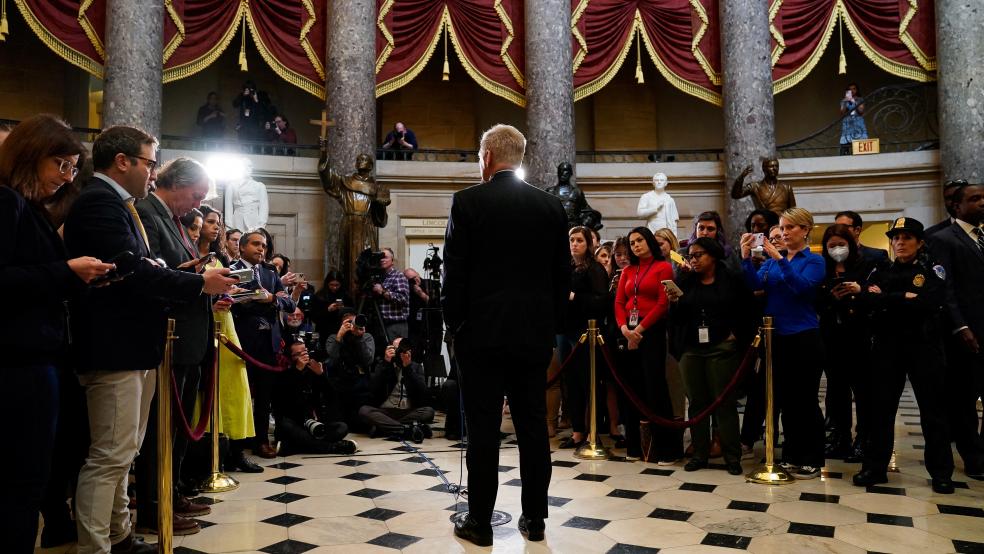House Speaker Kevin McCarthy (R-CA) indicated Thursday that Republicans may want to negotiate a deal with the White House to cut spending in exchange for an increase in the debt ceiling that averts a potentially catastrophic crisis.
"We don't want to put any fiscal problems to our economy and we won't," McCarthy said at his first weekly news conference since being elected speaker. “But fiscal problems would be continuing to do business as usual.”
McCarthy told reporters that he had raised the prospect of a negotiated deal when President Joe Biden called to congratulate him on becoming speaker. “I told him I’d like to sit down with him early and work through these challenges,” McCarthy said.
The Republican leader pointed to a two-year deal on the budget and debt limit reached in 2019 under the Trump administration and a Democratic-led House — though, as Roll Call’s Lindsey McPherson notes, that agreement involved lifting budget caps, not imposing them: “The Trump administration and Democrats agreed to avoid a $125 billion decrease in discretionary spending set to begin in fiscal 2020, with $77.4 billion in offsets, and suspend the debt ceiling through July 2021.”
And, as NPR’s Claudia Grisales points out, that 2019 deal was panned by conservatives for suspending the debt limit. In addition to that, McCarthy agreed as part of his deal with House conservatives that Republicans won’t back a debt limit hike that doesn’t also involve spending cuts or budget reforms.
Hitting the ceiling: The Treasury Department is expected to announce within days or weeks that it has bumped up against the $31.4 trillion borrowing limit for the federal government. That means that, while Treasury employs “extraordinary measures” to buy time and avert a debt default, congressional lawmakers will quickly be faced with the need to raise the federal borrowing limit. Rep. Brendan Boyle (D-PA), the top Democrat on the House Budget Committee, told MSNBC Wednesday night that the deadline for action could come as early as July or as late as September.
House Republicans have indicated that they’re looking to use the need to raise the debt limit as leverage to force Democrats to cut spending. “We’ve got to change the way we are spending money wastefully in the country, and we’re going to make sure that happens,” McCarthy told reporters. He said Republicans would protect Social Security and Medicare but would “scrutinize every single dollar spent.” House Republicans have agreed to put forth a budget resolution that reduces spending to fiscal year 2022 levels.
The White House and Democrats have rejected the idea of tying the debt limit to spending cuts. "Attempts to exploit the debt ceiling as leverage will not work," White House Press Secretary Karine Jean-Pierre said this week. "There will be no hostage-taking."
The White House has reportedly begun preparing for high-stakes negotiations. “Senior White House officials and aides from the Office of Legislative Affairs have already fanned out across the Hill, introducing themselves to freshman lawmakers and staff and zeroing in on moderate Republicans whom they imagine might be getable in a debt ceiling vote,” Politico reports, adding that the efforts are focused in particular on Republicans from districts President Joe Biden won in 2020 and those whose record suggests they might be persuadable.
Another path to avoid a crisis? Democrats are also engaged in informal talks aimed at convincing some more centrist Republicans to use a parliamentary process called a discharge petition to force a vote on raising the debt limit. Under the process, a majority of the House — 218 votes — can force a bill to come to the floor for a vote. That could allow a bipartisan group of House members to avoid any debt ceiling standoff, but it would likely require at least six Republicans to join with the 212 House Democrats.
That may not be easy —and the procedure itself wouldn’t be, either. “No discharge petition has been successful since 2015,” The Wall Street Journal notes.
The arcane process — read more about it here — can only be used on a measure that has been waiting in committee for at least 30 legislative days. Once the petition gets the signatures of a majority of members, it has to wait another nine legislative days before being brought to a vote. Given the congressional calendar, all those legislative days could take three or four months of real time. And the process has to start with a House bill, not one from the Senate. “We would already have to have an agreement in place with the Senate that they would pass it without changing even one semicolon,” the Budget Committee’s Boyle told MSNBC. Any Senate changes would require the process to start over.
The bottom line: One way or another, a dangerous standoff seems likely.


